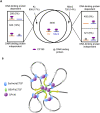Three subclasses of a Drosophila insulator show distinct and cell type-specific genomic distributions
- PMID: 19443682
- PMCID: PMC2701583
- DOI: 10.1101/gad.1798209
Three subclasses of a Drosophila insulator show distinct and cell type-specific genomic distributions
Abstract
Insulators are protein-bound DNA elements that are thought to play a role in chromatin organization and the regulation of gene expression by mediating intra- and interchromosomal interactions. Suppressor of Hair-wing [Su(Hw)] and Drosophila CTCF (dCTCF) insulators are found at distinct loci throughout the Drosophila melanogaster genome and function by recruiting an additional protein, Centrosomal Protein 190 (CP190). We performed chromatin immunoprecipitation (ChIP) and microarray analysis (ChIP-chip) experiments with whole-genome tiling arrays to compare Su(Hw), dCTCF, boundary element-associated factor (BEAF), and CP190 localization on DNA in two different cell lines and found evidence that BEAF is a third subclass of CP190-containing insulators. The DNA-binding proteins Su(Hw), dCTCF, and BEAF show unique distribution patterns with respect to the location and expression level of genes, suggesting diverse roles for these three subclasses of insulators in genome organization. Notably, cell line-specific localization sites for all three DNA-binding proteins as well as CP190 indicate multiple levels at which insulators can be regulated to affect gene expression. These findings suggest a model in which insulator subclasses may have distinct functions that together organize the genome in a cell type-specific manner, resulting in differential regulation of gene expression.
Figures




References
-
- Bailey TL, Elkan C. Fitting a mixture model by expectation maximization to discover motifs in biopolymers. Proc Int Conf Intell Syst Mol Biol. 1994;2:28–36. - PubMed
-
- Bell AC, Felsenfeld G. Methylation of a CTCF-dependent boundary controls imprinted expression of the Igf2 gene. Nature. 2000;405:482–485. - PubMed
Publication types
MeSH terms
Substances
Grants and funding
LinkOut - more resources
Full Text Sources
Molecular Biology Databases
